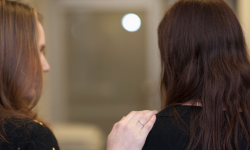The Women’s offers services to victim/survivors of both past and recent sexual assault through Centre Against Sexual Assault (CASA) House and the Sexual Assault Crisis Line (SACL).
Sexual assault
Sexual assault is any sexual behaviour that makes a person feel uncomfortable, frightened or threatened. It is sexual activity to which a person does not agree. The use of emotional or physical violence to force another person to engage in sexual activity also constitutes sexual assault.
Find out how to help a friend or who to call for help here.
Remember that victims/survivors never provoke sexual assault, they are never to blame and they are never responsible for the actions of the perpetrator.
Violence against women
Violence against women is the leading preventable cause of death and disability in Victorian women under the age of 45. Women who have been exposed to violence have a greater risk of developing a range of health problems including stress, anxiety, depression, pain syndromes, and phobias, somatic and medical symptoms. Violence against women includes intimate partner, family and domestic violence. The violence may be physical, sexual, verbal, psychological, emotional, financial, spiritual and cultural.
-
 CASA House
CASA HouseThe Women’s provides a 24 hour, seven day a week service to victim/survivors of sexual assault.
Learn more -
Sexual Assault Crisis Line
The Sexual Assault Crisis Line provide crisis counselling, support and advocacy for victims of past or recent sexual assault, including childhood sexual abuse.
Learn more
Disclaimer
The clinical information and Clinical Guidelines available on this Website are intended to provide guidance to health care professionals, based on a thorough evaluation of research evidence, on the practical assessment and management of specific clinical issues or situations. The Guidelines allow some flexibility on the part of the health care professional based on the needs of the specific patient for whom they are caring. Whilst appreciable care has been taken in the preparation of Clinical Guidelines, the Women's provides these as a service only and does not warrant the accuracy of these Guidelines. Any representation implied or expressed concerning the efficacy, appropriateness or suitability of any treatment or product is expressly negated. In view of the possibility of human error and / or advances in medical knowledge, the Women's cannot and does not warrant that the information contained in the Guidelines is in every respect accurate or complete. Accordingly, the Women's will not be held responsible or liable for any errors or omissions that may be found in any of the information on this Website. You are encouraged to consult other sources in order to confirm the information contained in any of the Guidelines and, in the event that medical treatment is required, to take professional, expert advice from a legally qualified and appropriately experienced medical practitioner. For practitioners outside the Women’s this material is made available in good faith as a resource for use by health professionals to draw on in developing their own protocols, guided by published medical evidence. In doing so, practitioners should themselves be familiar with the literature and make their own interpretations of it. NOTE: Care should be taken when printing any Clinical Guideline from this Website. Updates to these guidelines will take place as necessary. It is therefore advised that regular visits to this Website will be needed to access the most current version of these guidelines.